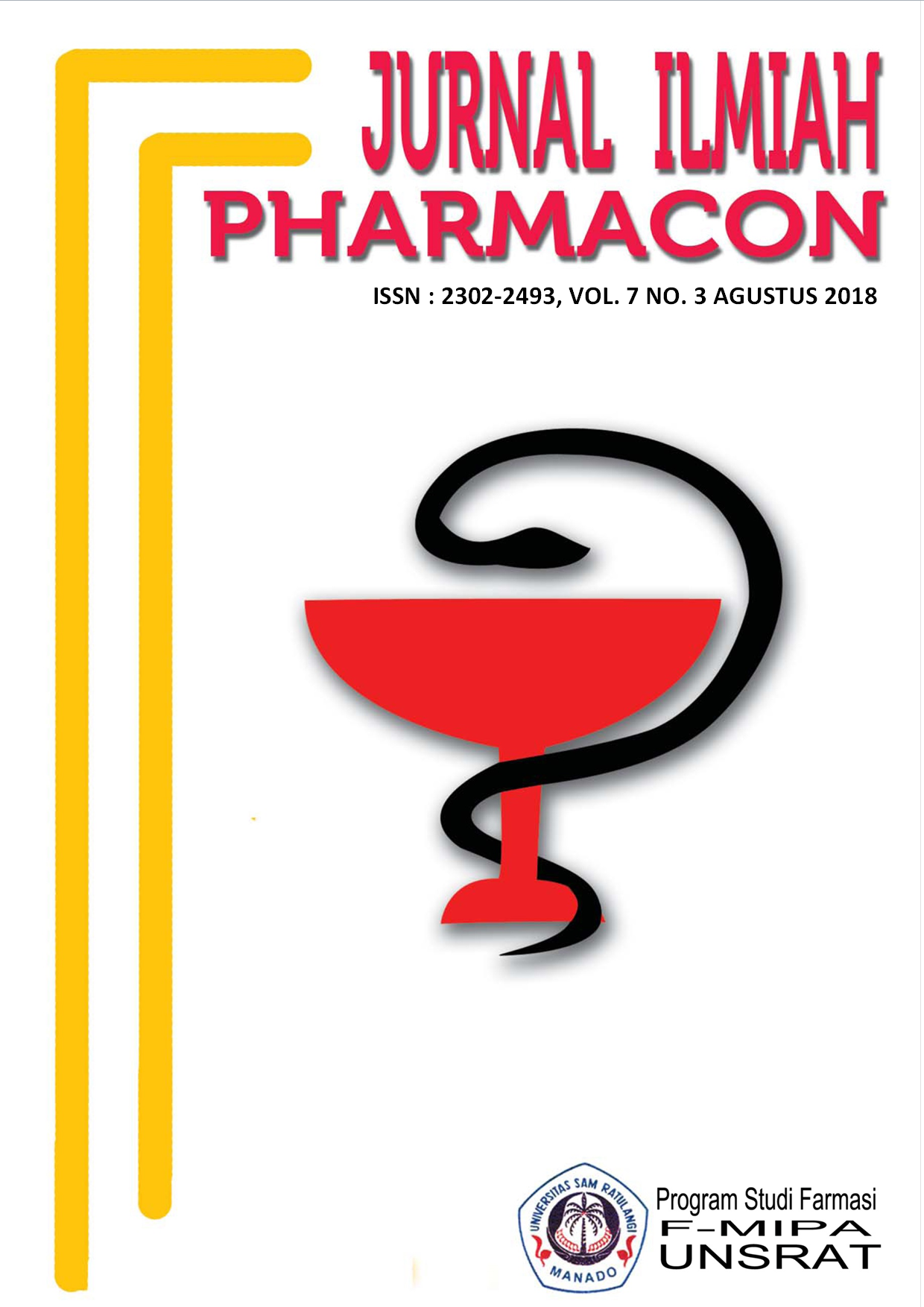PERUBAHAN KOMPONEN KIMIA PADA BEBERAPA TINGKAT KEMATANGAN DAUN SIRSAK ( Annona muricata L.) MENGGUNAKAN KROMATOGRAFI GAS (KG)
DOI:
https://doi.org/10.35799/pha.7.2018.20095Abstract
• PERUBAHAN KOMPONEN KIMIA PADA BEBERAPA TINGKAT KEMATANGAN DAUN SIRSAK ( Annona muricata L.) MENGGUNAKAN KROMATOGRAFI GAS (KG)
Yeremia F. Malibela1), Julius Pontoh2), Jemmy Abidjulu2)
1)Program Studi Farmasi FMIPA UNSRAT Manado, 95115
1)Jurusan Kimia FMIPA UNSRAT Manado, 95115
ABSTRACT
Soursop leaves (Annona muricata L.) is one of the medicinal plants of Annonaceae family that has great benefits for human life. The purpose of this study is to determine the development of chemical components at several levels of leaf age development by using gas chromatography equipment on young and old soursop leaves. The chemical components of soursop leaves are extracted into methanol and water solvents then derivatized with MTBSTFA prior to injection into gas chromatography. Changes in chemical components of soursop leaves can be seen as peak chemical content in Gas Chromatography. From the analysis there are 13 compounds which is the peak in the sample of young soursop leaves, 11 peaks on the leaves of soursop and the oldest 14 peaks on old soursop leaves. The content of chemical components in soursop leaves varies according to the leaf age progression rate. Some chemical components decrease with the older leaf age, some chemical components increase in the leaves of the old half and decreases in the old leaves. Some chemical components do not change in young and half-old leaves but are reduced to older leaves. The results of this study indicate that gas chromatography method can be used to analyze chemical components in soursop leaf.
Keyworsds: Soursop leaf (Annona muricata L.) Gas Chromatography, Retention Time
ABSTRAK
Daun Sirsak (Annona muricata L.) merupakan salah satu jenis tanaman obat dari familia Annonaceae yang mempunyai manfaat besar bagi kehidupan manusia. Tujuan penelitian ini untuk menentukan perkembangan komponen kimia pada beberapa tingkat perkembangan umur daun dengan mengunakan peralatan Kromatografi Gas pada daun sirsak muda setengah tua dan tua. Komponen kimia pada daun sirsak diekstraksi ke dalam pelarut metanol dan air kemudian diderivatisasi dengan MTBSTFA sebelum injeksi kedalam kromatografi gas. Perubahan komponen kimia pada daun sirsak dapat terlihat puncak kandungan kimia pada Kromatografi Gas. Dari hasil analisis terdapat 13 senyawa yang merupakan puncak pada sampel daun sirsak muda, 11 puncak pada daun sirsak setengah tua dan 14 puncak pada daun sirsak tua. Kandungan komponen kimia dalam daun sirsak berubah-ubah sesuai dengan tingkat perkembangan umur daun. Beberapa komponen kimia berkurang dengan makin tua umur daun, sebagian komponen kimia meningkat pada daun setengah tua dan menurun pada daun tua. Sebagian komponen kimia tidak berubah pada daun muda dan setengah tua tetapi berkurang pada daun tua. Hasil penelitian ini menunjukan bahwa metode kromatografi gas dapat digunakan untuk menganalisa komponen-komponen kimia pada daun sirsak.
Kata kunci: Daun sirsak (Annona muricata L.) Kromatografi Gas, Waktu Retensi
Â
Downloads
Published
How to Cite
Issue
Section
License
Authors who publish with this journal agree to the following terms:
- Authors retain copyright and grant the journal right of first publication with the work simultaneously licensed under a Creative Commons Attribution License that allows others to share the work with an acknowledgement of the work's authorship and initial publication in this journal.
- Authors are able to enter into separate, additional contractual arrangements for the non-exclusive distribution of the journal's published version of the work (e.g., post it to an institutional repository or publish it in a book), with an acknowledgement of its initial publication in this journal.
- Authors are permitted and encouraged to post their work online (e.g., in institutional repositories or on their website) prior to and during the submission process, as it can lead to productive exchanges, as well as earlier and greater citation of published work (See The Effect of Open Access)










